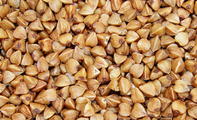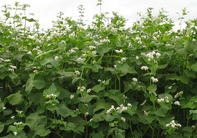Buckwheat (Fagopyrum esculentum), or (Fagopyrum esculentum Moench) is a high-protein flowering crop, grown for the use of its seed since ancient times. Popular in China, Russia and other Eastern European food cultures, buckwheat is not related to wheat, yet sometimes considered a ‘grain’ even if it is not a grass.

How to Grow Buckwheat
Gluten-free buckwheat ‘grains’ are eaten raw, sprouted or cooked into a porridge, ground up for buckwheat flour or used for brewing liquor. Buckwheat leaves are used for tea.
A small-seeded crop with a fine root system, buckwheat prefers a fine, firm seedbed with good drainage and can tolerate a variety of soil conditions. It does excellently on low nitrogen, light sandy soils with a slightly acidic to neutral pH. However, planted on low fertility soils, buckwheat performs better than other grains.
Sensitive to high summer temperatures and frost, sowing should only start after the most severe frost has passed, but before the peak of summer temperatures.
Moisture is required when flowering - four to five weeks after planting. Dry winds, high rainfall and drought during this time can result in yield loss.
Well-sown buckwheat will outcompete weeds and seldom experiences pest and disease problems.
Buckwheat will mature 10 - 12 weeks after sowing. It has an unpredictable growth habit with the upper region of the plant flowering while the lower region is already in seed. Harvesting (take a slow and gentle approach) should be done when about 75% of the seeds are ripe. Yield can be from 1 100 to 1600 kg/ha.
Buckwheat is not usually included in a crop rotation program as it is a heavy user of minerals, especially phosphorus. This should be considered when fertilizing for subsequent crops.
Buckwheat in Farming Systems
Buckwheat farming in South Africa is not usually included in a crop rotation program as it is a heavy user of minerals, especially phosphorus. This should be considered when fertilising for subsequent crops.
Dr Hans Kendal, agronomist of the North Dakota State University advises against planting buckwheat after canola, mustard or sunflower. He states, “These crops readily produce volunteer (leftover) plants that are impossible to control in growing buckwheat”.
As a green manure crop, buckwheat is beneficial as it produces large amounts of dry matter, and in the USA buckwheat is valuable as a fast-growing cover crop.
Buckwheat and Bees

Buckwheat exhibits continuous and long-lasting blooming and attracts a variety of insects, not only biological predators of other pests present on a farm, but also bees. Buckwheat, although relatively low in protein (11%) produces nectar and is a good foraging plant for bees. Honey production can range from 70 - 100 kg/ha to 300kg/ha on superior buckwheat cultivars.
Buckwheat performs best with cross-pollination and 2.5 hives/ha are recommended.
By Marinda Louw